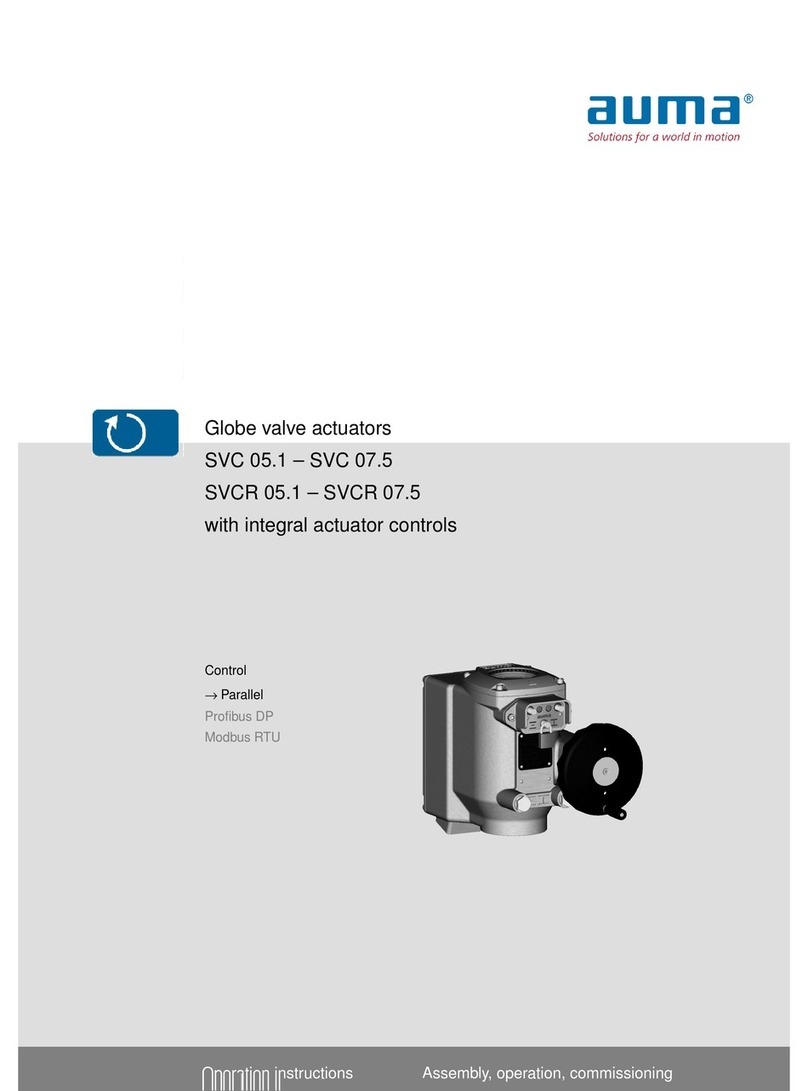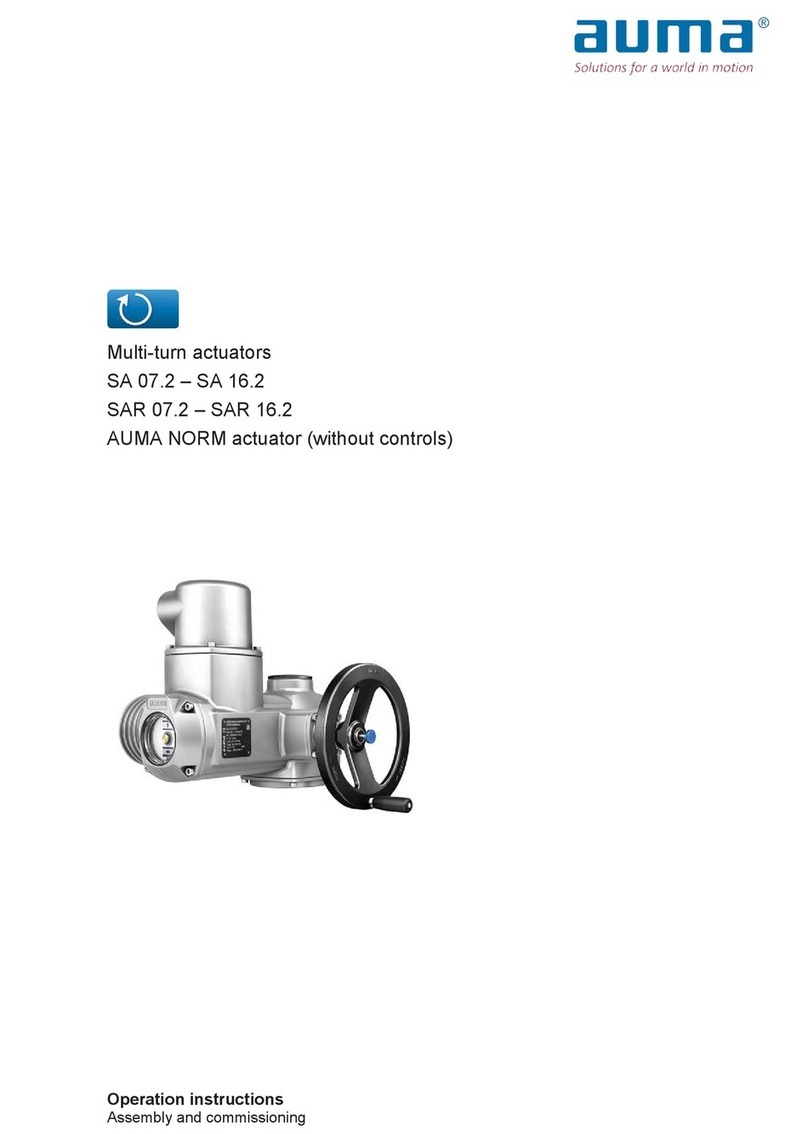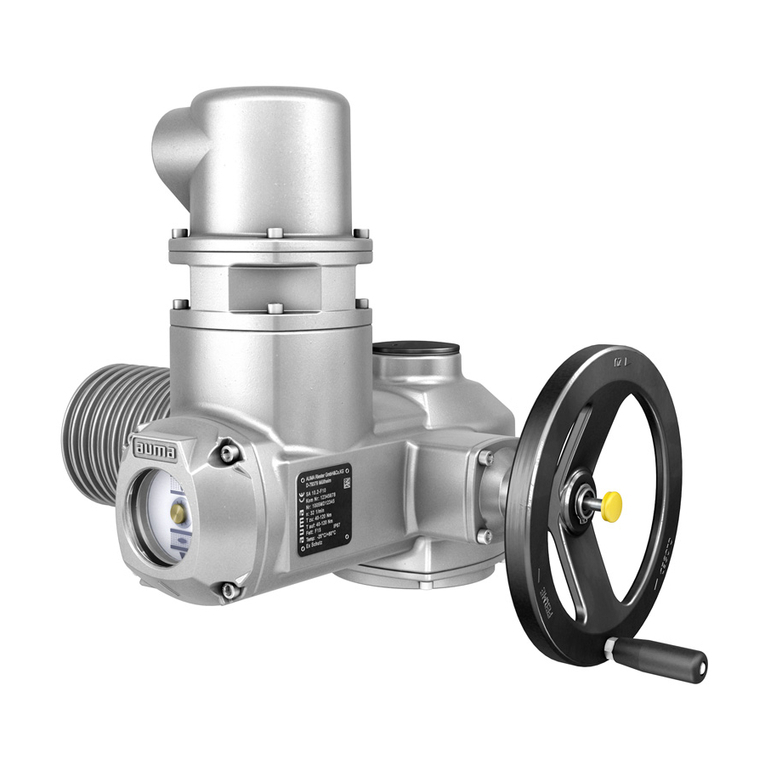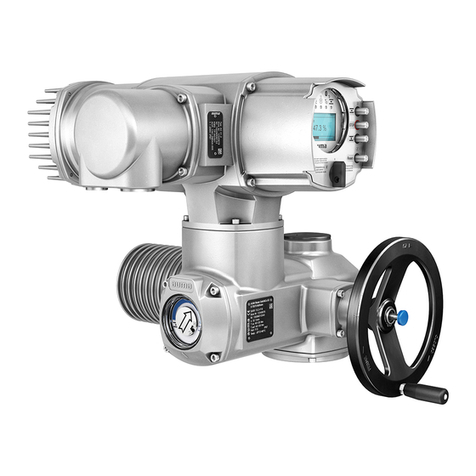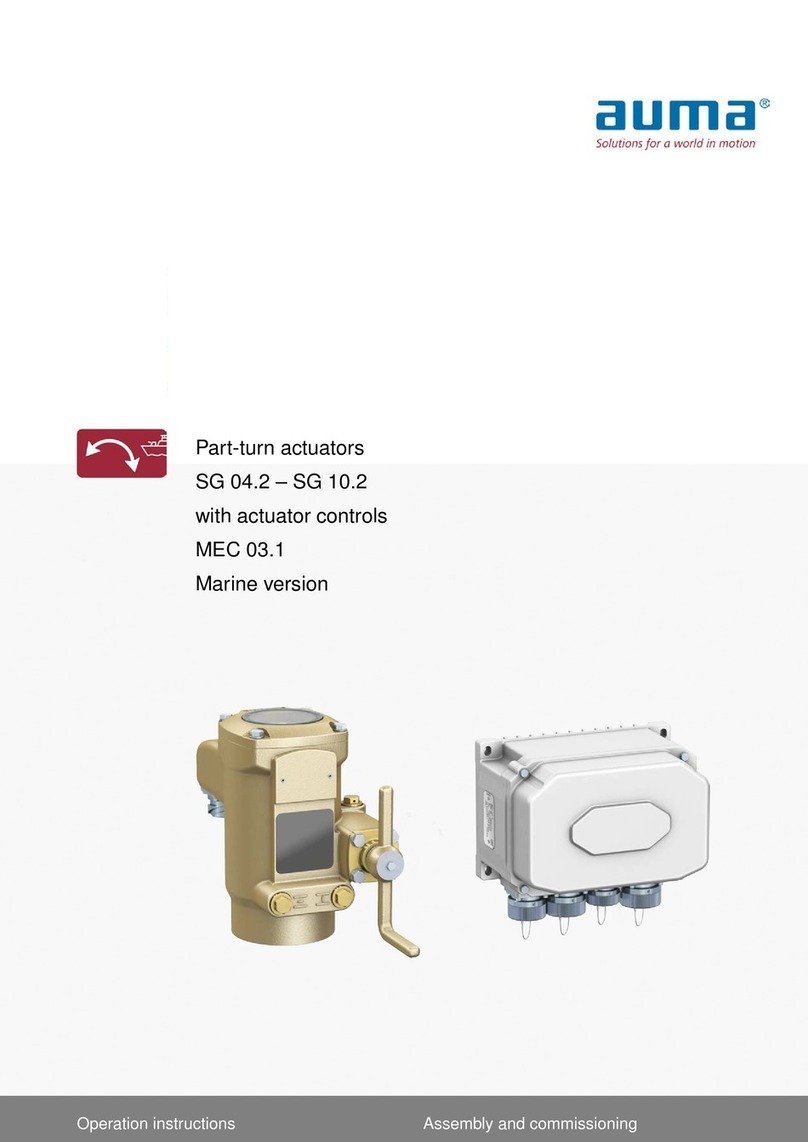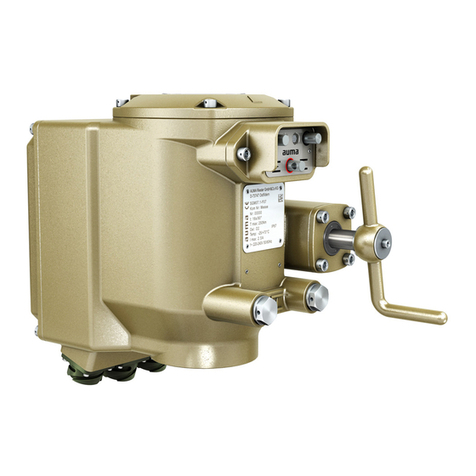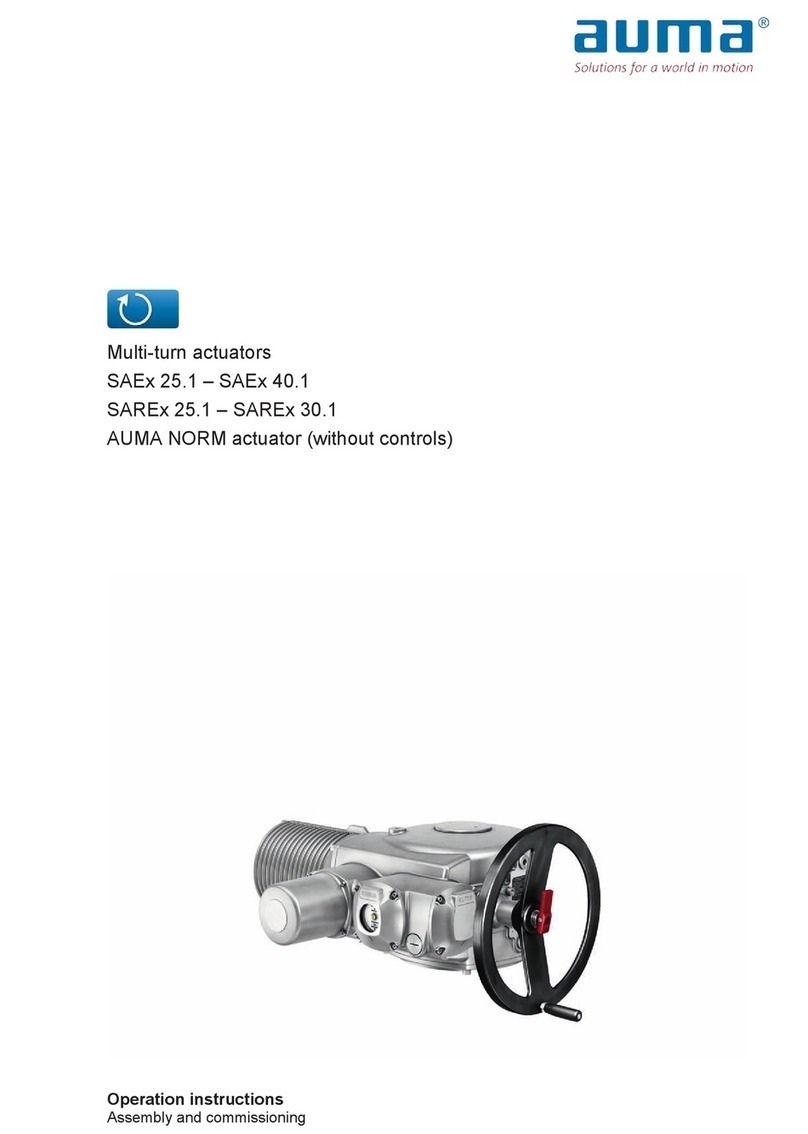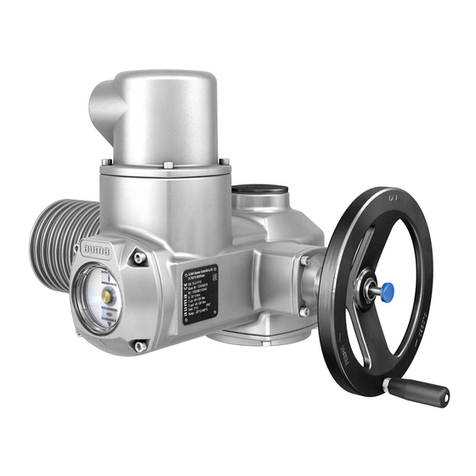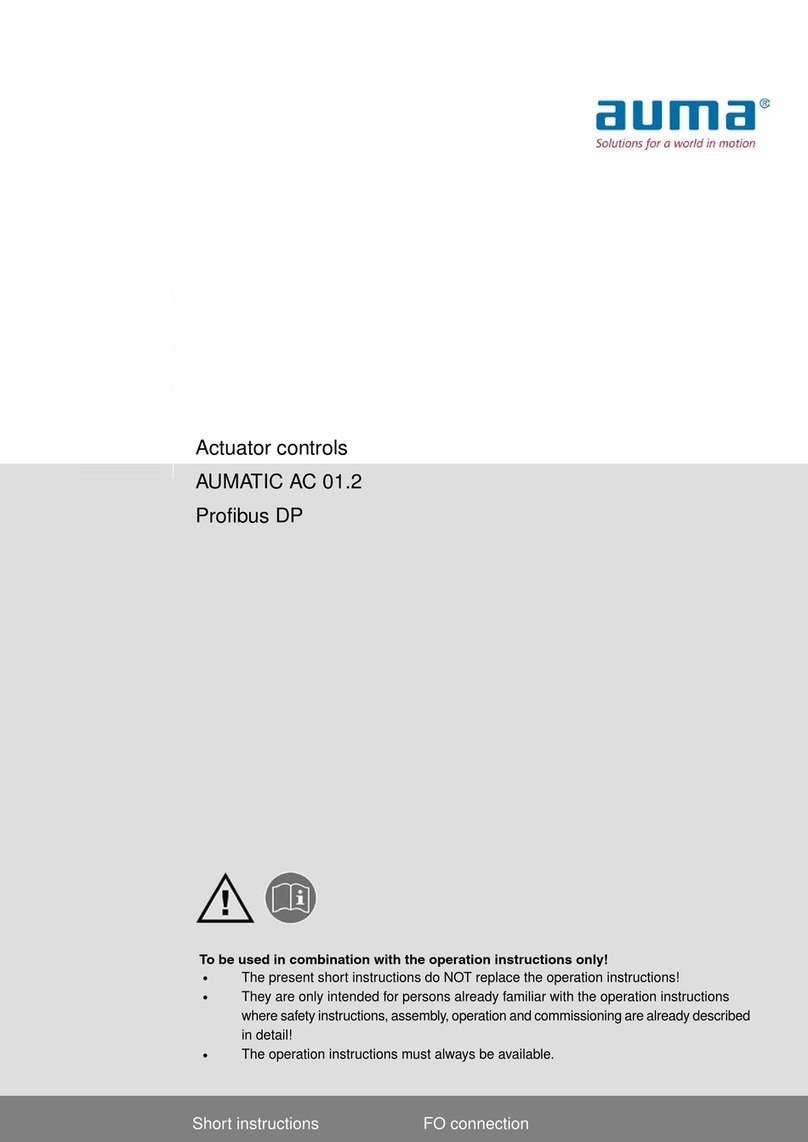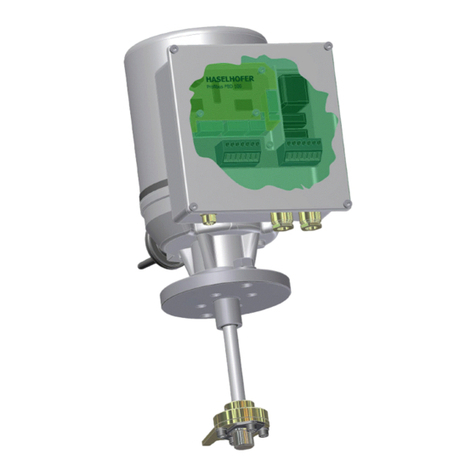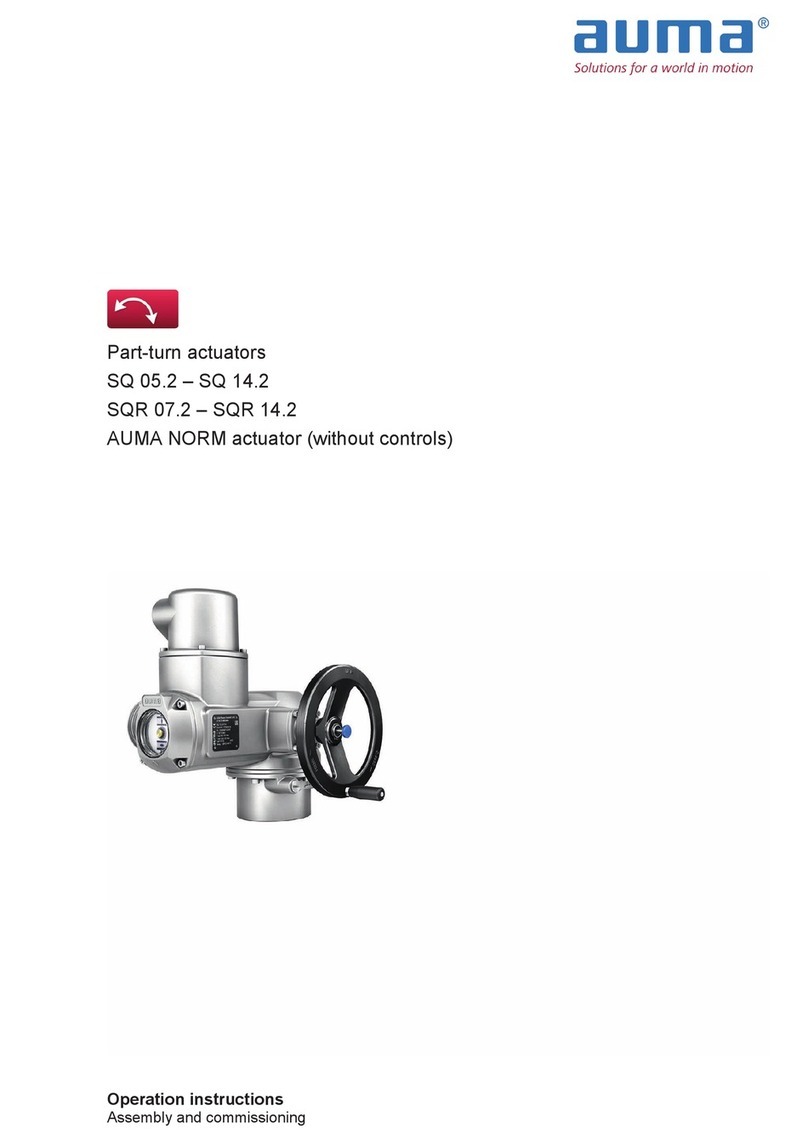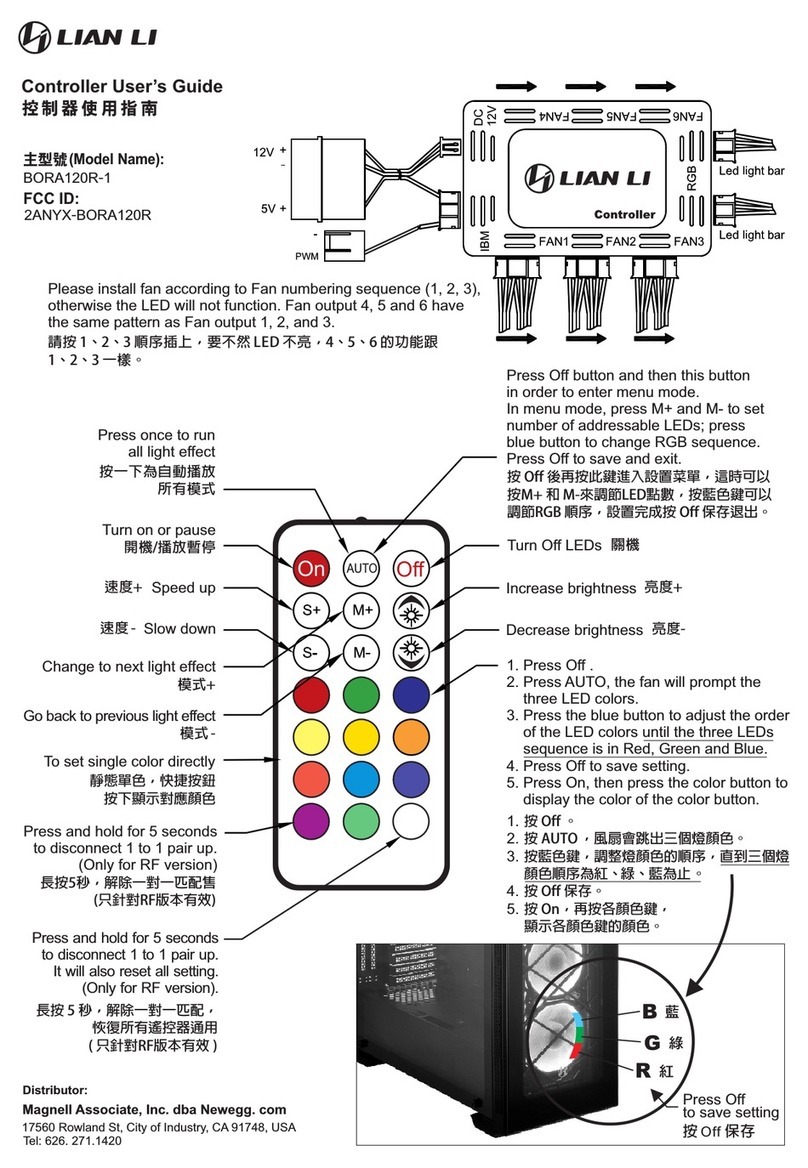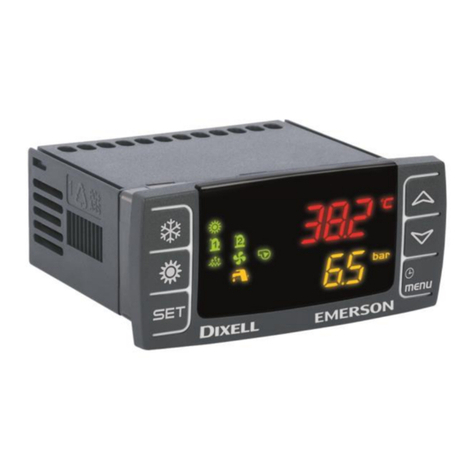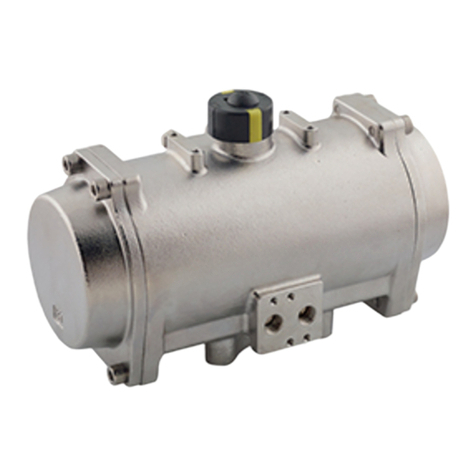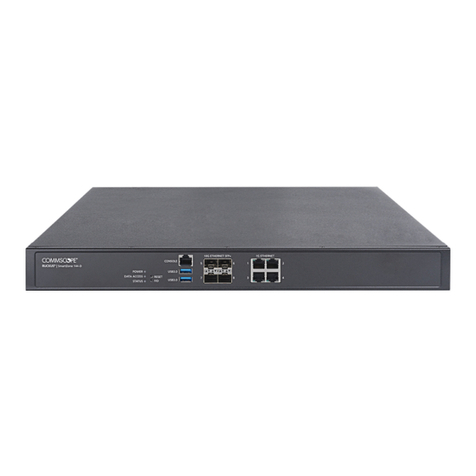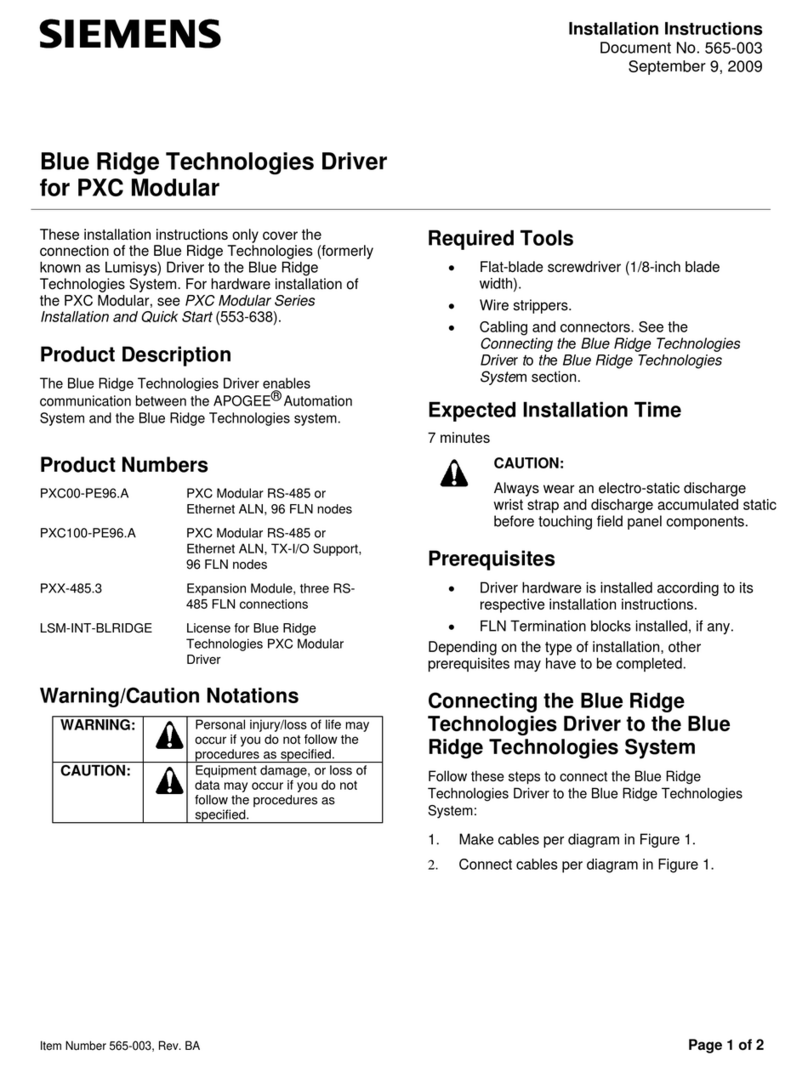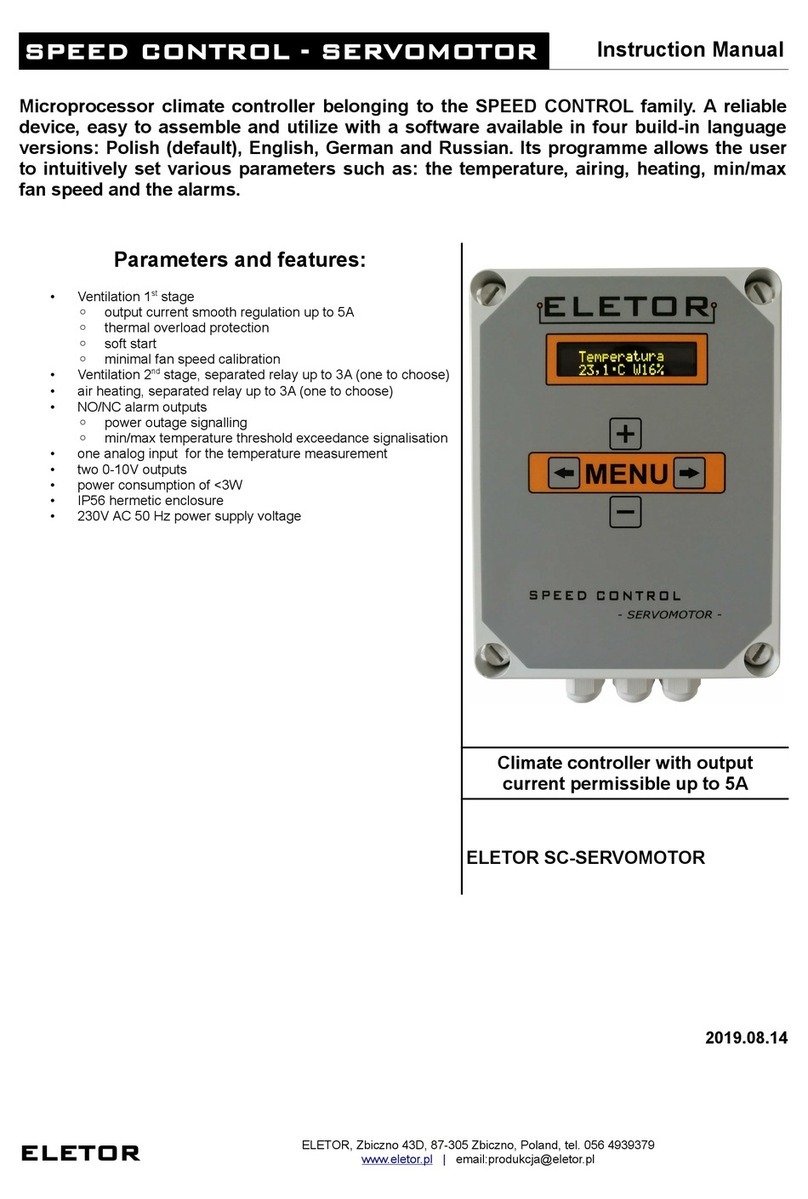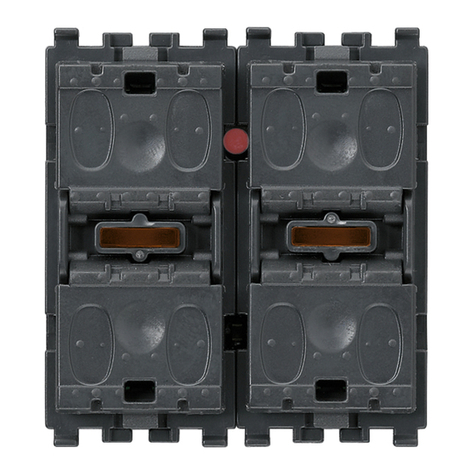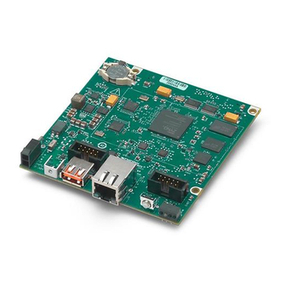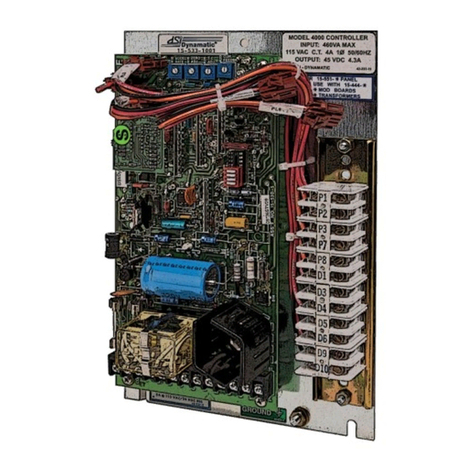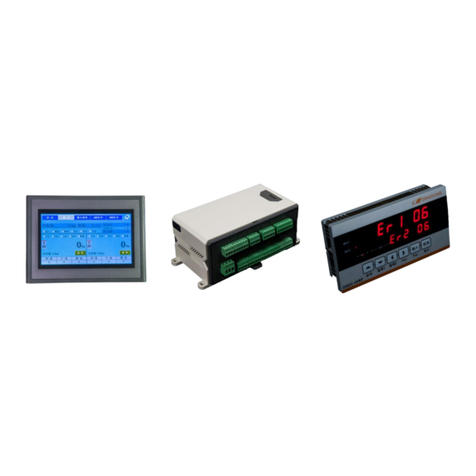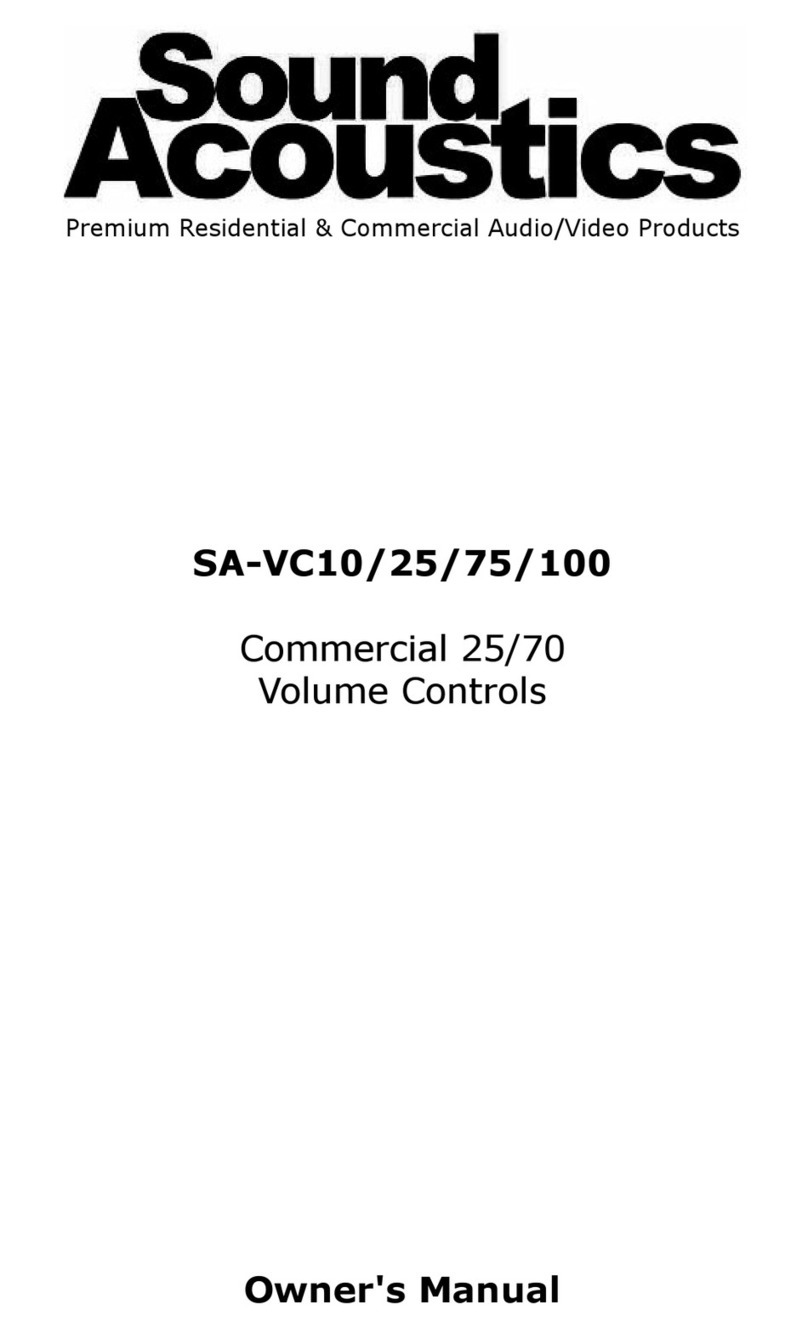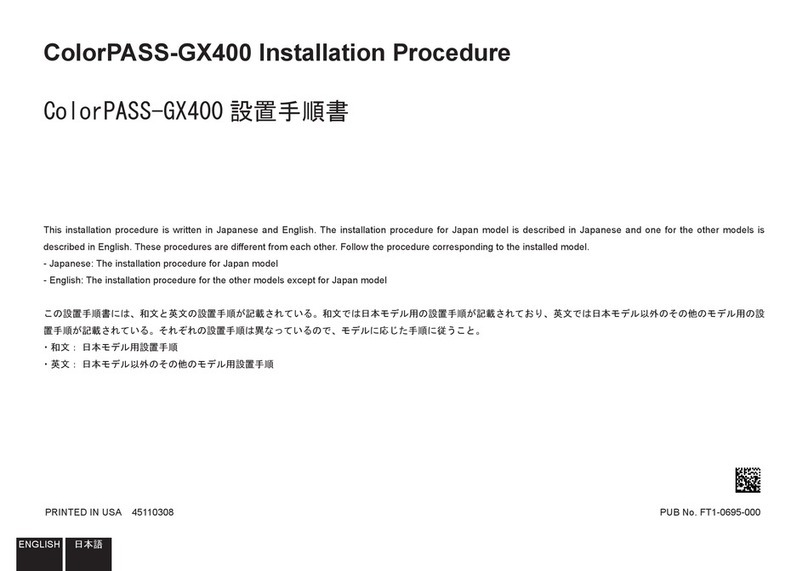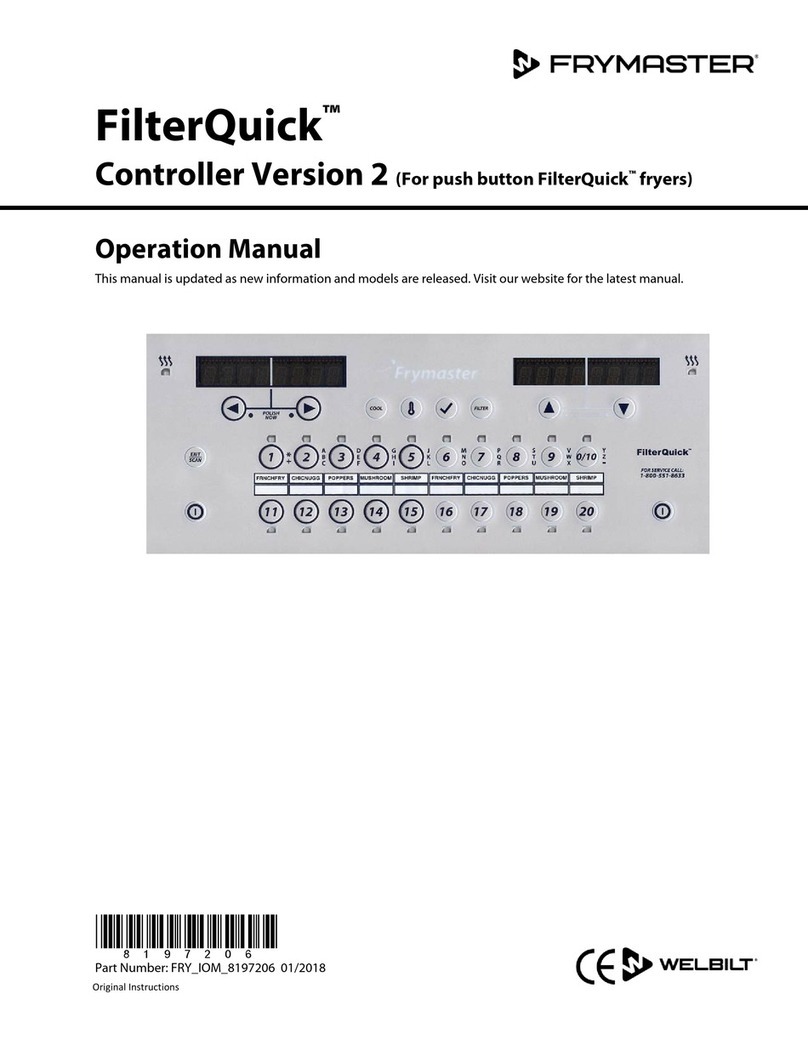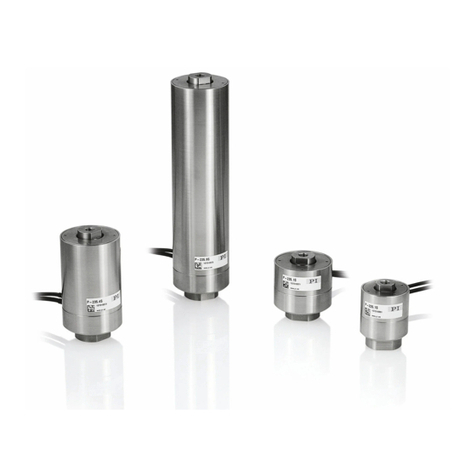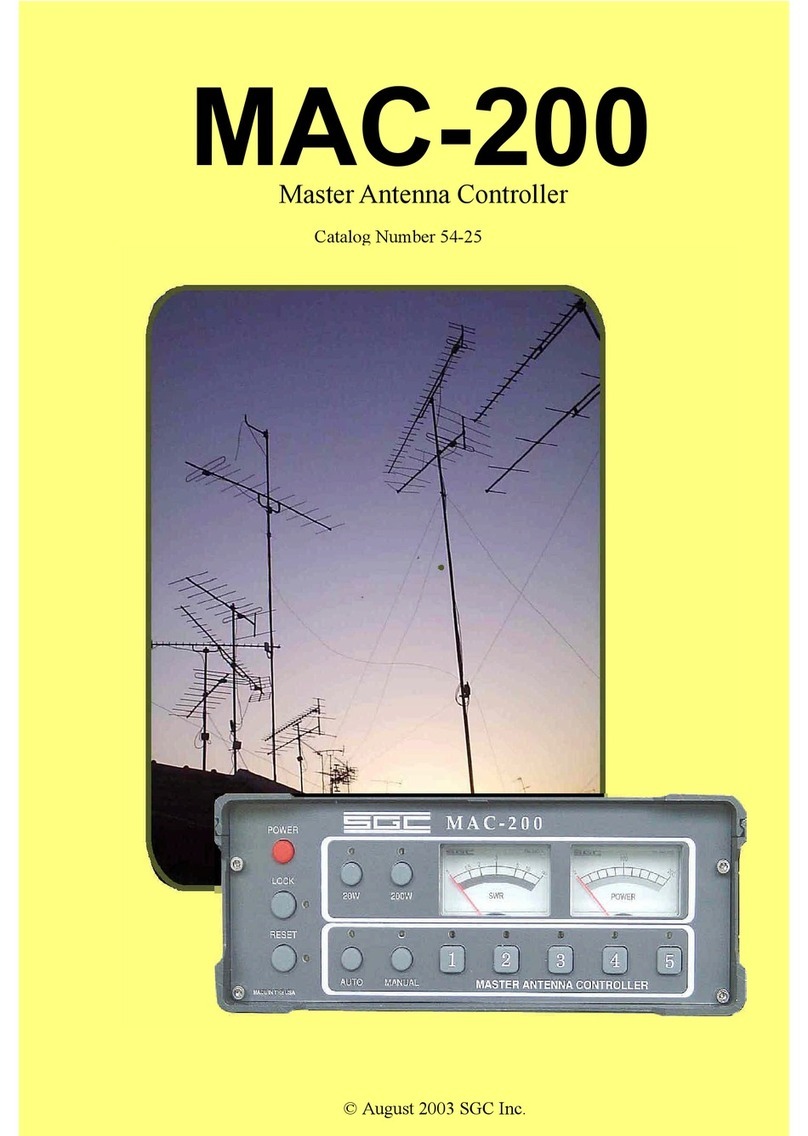AUMA AUMATIC AC 01.2 User manual

Actuator controls
AUMATIC AC 01.2/ACExC 01.2
Modbus RTU
Device integration FieldbusManual

Read operation instructions first.
●Observe safety instructions.
Purpose of the document:
This document contains information for the commissioning staff of the distributed control system and DCS software
engineers.This document is intended to support the actuator integration into the DCS via fieldbus interface.
Reference documents:
●Operation instructions (Assembly, operation, commissioning) for actuator
●Manual (Operation and setting) AUMATIC AC 01.2 Modbus
Reference documents can be downloaded from the Internet (www.auma.com) or ordered directly from AUMA
(refer to <Addresses>).
Table of contents Page
41. Safety instructions................................................................................................................. 41.1. Basic information on safety 41.2. Range of application 51.3. Warnings and notes 51.4. References and symbols
62. General information about Modbus...................................................................................... 62.1. Basic characteristics 62.2. Modbus basic functions 62.3. Transfer mode 62.4. Bus access 62.5. Communication 72.6. Protective functions 72.7. Modbus RTU mode
83. Commissioning...................................................................................................................... 83.1. Introduction 83.1.1. Modbus function overview 83.1.1.1. Functions for data transmission 83.1.1.2. Diagnostic functions 93.1.2. Modbus function and pertaining offset addresses of the AUMATIC 93.1.3. Operation parameters of the actuator
104. Description of the data interface.......................................................................................... 104.1. Input data –signals 104.1.1. Reading input data from the actuator using register functions 124.1.2. Description of the input data 244.1.3. Reading the feedback signals from the actuator using status functions 284.2. Output data –operation commands 284.2.1. Transmitting or reading out operation commands from the actuator using register
functions 294.2.2. Description of the output data 344.2.3. Transmitting operation commands from the actuator using Coil functions 354.3. Redundancy 354.3.1. Redundant behaviour according to AUMA redundancy 374.3.2. Redundant behaviour using both a redundant loop and the SIMA master station
2
Actuator controls
Table of contents AC 01.2/ACExC 01.2 Modbus RTU

405. Description of Modbus board............................................................................................... 405.1. Indications (indication and diagnostic LEDs)
426. Corrective action.................................................................................................................... 426.1. Troubleshooting 426.2. Diagnostics
447. Technical data......................................................................................................................... 447.1. Modbus interface
468. Appendix................................................................................................................................. 468.1. Proposed wiring diagram for external sensors, 2-wire technology 478.2. Proposed wiring diagram for external sensors, 3-wire technology 488.3. Proposed wiring diagram for external sensors, 4-wire technology 498.4. Parameters
76Index........................................................................................................................................
77Addresses...............................................................................................................................
3
Actuator controls
AC 01.2/ACExC 01.2 Modbus RTU Table of contents

1. Safety instructions
1.1. Basic information on safety
Standards/directives AUMA products are designed and manufactured in compliance with recognised
standards and directives.This is certified in a Declaration of Incorporation and a EC
Declaration of Conformity.
The end user or the contractor must ensure that all legal requirements, directives,
guidelines, national regulations and recommendations with respect to assembly,
electrical connection, commissioning and operation are met at the place of installation.
They include among others applicable configuration guidelines for fieldbus
applications.
Safetyinstructions/warn-
ings All personnel working with this device must be familiar with the safety and warning
instructions in this manual and observe the instructions given. Safety instructions
and warning signs on the device must be observed to avoid personal injury or property
damage.
Qualification of staff Assembly, electrical connection, commissioning, operation, and maintenance must
be carried out exclusively by suitably qualified personnel having been authorised by
the end user or contractor of the plant only.
Prior to working on this product, the staff must have thoroughly read and understood
these instructions and, furthermore, know and observe officially recognised rules
regarding occupational health and safety.
Commissioning Prior to commissioning, it is important to check that all settings meet the requirements
of the application. Incorrect settings might present a danger to the application, e.g.
cause damage to the valve or the installation.The manufacturer will not be held
liable for any consequential damage. Such risk lies entirely with the user.
Operation Prerequisites for safe and smooth operation:
●Correct transport, proper storage, mounting and installation, as well as careful
commissioning.
●Only operate the device if it is in perfect condition while observing these instruc-
tions.
●Immediately report any faults and damage and allow for corrective measures.
●Observe recognised rules for occupational health and safety.
●Observe the national regulations.
●During operation,thehousing warms upandsurface temperatures>60°Cmay
occur.To prevent possible burns, we recommend to the check surface temper-
ature with an appropriate thermometer prior to working with device and to wear
protective gloves, if required.
Protective measures The end user or the contractor are responsible for implementing required protective
measures on site, such as enclosures, barriers, or personal protective equipment
for the staff.
Maintenance Any device modification requires the consent of the manufacturer.
1.2. Range of application
AUMA actuator controls are exclusively designed for the operation of AUMA actuators.
Other applications require explicit (written) confirmation by the manufacturer.The
following applications are not permitted, e.g.:
●motor control
●pump control
No liability can be assumed for inappropriate or unintended use.
Observance of these operation instructions is considered as part of the device's
designated use.
4
Actuator controls
Safety instructions AC 01.2/ACExC 01.2 Modbus RTU

1.3. Warnings and notes
The following warnings draw special attention to safety-relevant procedures in these
operation instructions, each marked by the appropriate signal word (DANGER,
WARNING, CAUTION, NOTICE).
Indicates an imminently hazardous situation with a high level of risk. Failure
to observe this warning could result in death or serious injury.
Indicates a potentially hazardous situation with a medium level of risk.Failure
to observe this warning could result in death or serious injury.
Indicates a potentially hazardous situation with a low level of risk. Failure to
observe this warning may result in minor or moderate injury.May also be used
with property damage.
Potentially hazardous situation. Failure to observe this warning may result in
property damage. Is not used for personal injury.
Arrangement and typographic structure of the warnings
Type of hazard and respective source!
Potential consequence(s) in case of non-observance (option)
→Measures to avoid the danger
→Further measure(s)
Safety alert symbol warns of a potential personal injury hazard.
The signal word (here: DANGER) indicates the level of hazard.
1.4. References and symbols
The following references and symbols are used in these instructions:
Information The term Information preceding the text indicates important notes and information.
Symbol for CLOSED (valve closed)
Symbol for OPEN (valve open)
Important information before the next step.This symbol indicates what is required
for the next step or what has to be prepared or observed.
Via the menu to parameter
Describes the path within the menu to the parameter. By using the push buttons of
the local controls you may quickly find the desired parameter in the display.
< > Reference to other sections
Terms in brackets shown above refer to other sections of the document which provide
further information on this topic.These terms are either listed in the index, a heading
or in the table of contents and may quickly be found.
5
Actuator controls
AC 01.2/ACExC 01.2 Modbus RTU Safety instructions

2. General information about Modbus
For exchange of information among automation systems and the connected
decentralised field devices, the use of serial fieldbus systems for communication is
state-of-the-art.Thousands of applications have proved impressively that, in
comparison with conventional technology, cost savings of up to 40 % in wiring,
commissioning, and maintenance are achieved by using fieldbus technology.While
in the past the fieldbus systems used were often manufacturer specific and
incompatible with other bus systems, those implemented today are almost exclusively
open and standardized.This means that the user does not depend on individual
suppliers and can choose within a large product range the most suitable product at
the most competitive price.
Modbus is an open fieldbus system used successfully throughout the world.The first
Modbus solution was initiated as early as 1979. Since then, Modbus has developed
into a de-facto standard. Meanwhile, Modbus has been standardised by the IEC
61158 and IEC 61784 standards.This standardization ensures that the investments
by manufacturers and users are protected to the best possible degree and the user
no longer depends on one manufacturer.The application range includes automation
in the areas of manufacturing, processing, and building.
2.1. Basic characteristics
Modbus defines the technical and functional features of a serial fieldbus system used
for interconnecting distributed digital automation devices. Modbus distinguishes
between master and slave devices.
Master devices Master devices control data traffic on the bus.A master is allowed to send messages
without an external request. Masters are also called "active devices" in the Modbus
protocol.
Slave device Slave devices such as AUMA Modbus actuators are peripheral devices.Typical
slave devices are input/output devices, valves, actuators, and measuring transducers.
They do not have bus access rights, i.e.they may only acknowledge received
messages or, at the request of a master, transmit messages to that master. Slaves
are also called ‘passive devices’.
2.2. Modbus basic functions
Modbus uses a master-slave technique where only the master can initiate a
transaction.The slaves respond by supplying the requested data in a response
message or by executing the action requested in the query.
The Modbus telegram from the master contains the slave address, a function code
defining the requested action, a data field, and a CRC field.The Modbus slaves’
response message contains fields confirming the requested action and possibly the
requested data as well as a CRC field.
If an error occurs during reception of the telegram or if the slave is unable to perform
the requested action, the slave will generate an error telegram and send it as response
to the master.
2.3. Transfer mode
●RS-485 twisted pair cable or fibre optic cable.
●AUMA actuators with controls AUMATIC AC 01.2/ACExC 01.2 support baud
rates up to 115.2 kbits/s.
2.4. Bus access
●Master-slave technique
●Mono-master system
●Master and slave devices: max.247 devices at one bus, without repeater max.
32 devices.
2.5. Communication
●Master-slave data exchange via request-response cycle (polling procedure).
6
Actuator controls
General information about Modbus AC 01.2/ACExC 01.2 Modbus RTU

●Modbus RTU protocol
2.6. Protective functions
●Parity check for each telegram byte
●CRC check for each telegram
●Watchdog for AUMA actuators with adjustable failure behaviour.
●Request-response cycle monitoring with configurable timer interval at the
master.
2.7. Modbus RTU mode
Data format for a byte
Coding system:
●8 bit binary, hexadecimal 0-9, A-F
●hexadecimal characters contained in each 8 bit field of the telegram
Bits per byte:
●1 start bit
●8 data bits; least significant bit sent first
●1 bit for even/odd parity, no bit for no parity
●1 stop bit if parity is used, 1 or 2 stop bits if no parity is used.
7
Actuator controls
AC 01.2/ACExC 01.2 Modbus RTU General information about Modbus

3. Commissioning
3.1. Introduction
To commission a Modbus slave, a special configuration of the master using a
configuration file is usually not required.
The Modbus RTU transmission is based on a simple protocol containing the slave
address, a function code with offset address, the process data, and a checksum.
3.1.1. Modbus function overview
3.1.1.1. Functions for data transmission
DescriptionFunction code
(decimal)
Function
Sets an individual bit in the slave to ON or OFF.05Force Single Coil Sets several consecutive bits in the slave to ON or OFF.15Force Multiple Coils Reads out the status of individual pieces of output bit information from the
slave.
01Read Coil Status
Reads out the status of individual pieces of input bit information from the slave.02Read Input Status Writes data to individual Holding Registers (16 bit) of the slave.06Preset Single Register Writes data into consecutive Holding Registers.16Preset Multiple Register Reads out the contents of the Input Data Registers (16 Bit) from the slave04Read Input Register Reads out the contents of the Holding Registers.03Read Holding Register
3.1.1.2. Diagnostic functions
DescriptionFunction code
(decimal)
Function
Reads diagnostic data.
●00 00 Loopback
●00 10 (0AHex) Clear Counters and Diagnostic Register
●00 11 (0BHex) Return Bus Message Count
●00 12 (0CHex) Return Bus Communication Error Count
●00 13 (0DHex) Return Bus Exception Error Count
●00 14 (0EHex) Return Slave Message Count
●00 15 (0FHex) Return Slave No Response Count
●00 16 (10Hex) Return Slave NAK Count
●00 17 (11Hex) Return Slave Busy Count
●00 18 (12Hex) Return Character Overrun Count
08Diagnostics
Reads the device-specific data from the slave.
●Byte 1: Slave Address
●Byte 2: 0x11 (Function Code)
●Byte 3: Byte Count = 97
●Byte 4: 0x01 (Ident Code)
●Byte 5: 0x00 = Not ready REMOTE, 0xFF = Ready REMOTE
●from byte 6 (vendor, 18 bytes): AUMA Riester GmbH
●from byte 24 (actuator controls order number, 18 bytes)
●from byte 42 (firmware version, 13-byte ASCII string)
●from byte 55 (device tag, 20-byte ASCII string)
●from byte 75 (actuator controls serial number, 13-byte ASCII string)
●from byte 88 (actuator controls serial number, 13-byte ASCII string)
17Report Slave ID
8
Actuator controls
Commissioning AC 01.2/ACExC 01.2 Modbus RTU

3.1.2. Modbus function and pertaining offset addresses of the AUMATIC
Permissible offset addresses
(hexadecimal)
Permissible offset addresses
(decimal)
Permissible function/func-
tion code
(decimal)
Action
0x0000 to 0x01FF0 to 511Force Single Coil (05)
Force Multiple Coils (15)
Read Coil Status (01)
Read or write process repres-
entation output data (master
outputs) 0x03E8 to 0x04071,000 to 1,031Preset Single Register (06)
Preset Multiple Register (16)
Read Holding Register (03) 0x0000 to 0x01FF0 to 511Read Input Status (02)Read process representation
input data (master inputs) 0x03E8 to 0x04071,000 to 1,031Read Input Register (04) 0x0408 to 0x04271,032 to 1,063Read Holding Register (03) 0x04B0 to 0x05DBView Objects:1,200 to 1,499
(refer to <Parameters>)
Individual parameter requests
from 2,000
Preset Multiple Register (16)
Read Holding Register (03)
Read or write AUMATIC para-
meters
3.1.3. Operation parameters of the actuator
Parameters and instructions for setting of the AUMATIC via Modbus RTU (Modbus
function codes, offset addresses, parameter descriptions as well as the read/write
access codes) are described in the appendix.
Functions to be used
AUMATIC parameters can be written or read using of the following functions:
●Preset Multiple Register (16)
●Read Holding Register (03).
9
Actuator controls
AC 01.2/ACExC 01.2 Modbus RTU Commissioning

4. Description of the data interface
4.1. Input data –signals
The master (controls) can read the state of the slave (actuator) by means of the input
data.
4.1.1. Reading input data from the actuator using register functions
Function to be used: Read Input Register (04)
When using the Read Holding Register (03) function, an additional offset of 32 has
to be addressed (1032 –1063 or 0x0408 –0x0472).
Grey bits are collective signals.They contain the results of a disjunction (OR
operation) of other information.
Register contentsOffset (decimal)Offset (hexadecimal) 10000x03E8
Byte 3: Actual position high byte (position transmitter)
Byte 4: Actual position low byte (position transmitter)
10010x03E9
10020x03EA
10030x03EB
Byte 9: Input AIN 1 (high byte)
Byte 10: Input AIN 1 (low byte)
10040x03EC
Byte 11 Torque (high byte)
Byte 12:Torque (low byte)
10050x03ED
10
Actuator controls
Description of the data interface AC 01.2/ACExC 01.2 Modbus RTU

Register contentsOffset (decimal)Offset (hexadecimal) 10060x03EE
10070x03EF
10080x03F0
10090x03F1
Byte 21: Input AIN 2 (high byte)
Byte 22: Input AIN 2 (low byte)
10100x03F2
10110x03F3
11
Actuator controls
AC 01.2/ACExC 01.2 Modbus RTU Description of the data interface

Register contentsOffset (decimal)Offset (hexadecimal) 10120x03F4
10130x03F5
10140x03F6
10150x03F7
Byte 33 to byte 40:Reserve1016 –10190x03F8 –0x03FB
4.1.2. Description of the input data
Byte 1: Logical signals
Bits 3, 6, and 7 are collective signals.
Bits 5 and 4 of the logical signals (byte1) indicate a logical operation of the actuator,
i.e.they are set when the actuator has received the command to perform an electrical
operation (also active when e.g.the actuator is in a stepping pause during stepping
mode or waiting for the end of the dead time).
12
Actuator controls
Description of the data interface AC 01.2/ACExC 01.2 Modbus RTU

Table 1: Byte 1: Logical signals
DescriptionValueDesignation
(process representation)
Bit
For limit seating: Limit switch operated in direction OPEN
For torque seating:Torque switch and limit switch operated in direction OPEN
1
Bit: End p. OPEN
0
No signal0 For limit seating: Limit switch operated in direction CLOSE
For torque seating:Torque switch and limit switch operated in direction CLOSE
1
Bit: End p. CLOSED
1
No signal0 The setpoint is within max. error variable (outer dead band).Is only signalled if
Modbus master has set the Fieldbus SETPOINT bit (process representation output).
1
Bit: Setpoint reached
2
No signal0 Collective signal 04:
Contains the result of a disjunction (OR-operation) of all bits comprised in bytes 13
and 14 (Not ready REMOTE 1 and Not ready REMOTE 2).
The actuator cannot be operated from REMOTE.
The actuator can only be operated via the local controls.
1
Bit: Not ready REMOTE
3
In bytes 13 and 14, no signals are active (all bits are set to 0).0 An operation command in direction OPEN is performed via fieldbus:Fieldbus OPEN
or Fieldbus SETPOINT (process representation output).This bit remains also set
during operation pauses (e.g.due to the dead time or the reversing prevention time).
1
Bit: Running OPEN
4
Operation in direction OPEN via fieldbus is not executed.0 An operation command in direction CLOSE is performed via fieldbus:Fieldbus CLOSE
or Fieldbus SETPOINT (process representation output).This bit remains also set
during operation pauses (e.g.due to the dead time or the reversing prevention time).
1
Bit: Running CLOSE
5
Operation in direction CLOSE via fieldbus is not executed.0 Collective signal 02:
Contains the result of a disjunction (OR-operation) of all bits of bytes 17 to 20
(Warning 1 to Warning 4).
1
Bit: Warnings
6
In bytes 17 and 20, no warnings are active (all bits are set to 0).0 Collective signal 03:
Contains the result of a disjunction (OR-operation) of all bits of bytes 15 and 16 (Fault
1 and Fault 2).
The actuator cannot be operated.
1
Bit: Fault
7
In bytes 15 and 16, no faults are active (all bits are set to 0).0
Byte 2: Actuator signals
Table 2: Byte 2: Actuator signals
DescriptionValueDesignation
(process representation)
Bit
Motor protection tripped1
Bit: Thermal fault
0No signal0
●When connecting to a 3-ph AC system and with internal 24 V DC supply of the
electronics: Phase 2 is missing.
●When connecting to a 3-ph or 1-ph AC system and with external 24 V DC supply
of the electronics: One of the phases L1, L2 or L3 is missing.
1
Bit: Phase failure
1
All phases are available.0 Selector switch is in position REMOTE.1
Bit: Sel. sw. REMOTE
2Selector switch is not in position REMOTE.0 Selector switch is in position LOCAL.1
Bit: Sel. sw. LOCAL
3Selector switch is not in position LOCAL.0 Limit switch operated in direction OPEN1
Bit: Limit sw. OPEN
4No signal0 Limit switch operated in direction CLOSE1
Bit: Limit sw. CLOSED
5No signal0
13
Actuator controls
AC 01.2/ACExC 01.2 Modbus RTU Description of the data interface

DescriptionValueDesignation
(process representation)
Bit
Torque switch operated in direction OPEN.1
Bit: Torque sw.OPEN
6No signal0 Torque switch operated in direction CLOSE.1
Bit: Torque sw.CLOSE
7No signal0
Bytes 3 and 4: Actual position
Byte 3 = high byte, byte 4 = low byte.
If a position transmitter (potentiometer, RWG, EWG, or MWG) is installed in the
actuator, bytes 3 and 4 are used to transmit the current actuator position.The value
is transmitted in per mil (value: 0 –1,000).
Byte 5: Device status
Table 3: Byte 5: Device status
DescriptionValueDesignation
(process representation)
Bit
Collective signal 04:
Contains the result of a disjunction (OR-operation) of all bits comprised in bytes 13
and 14 (Not ready REMOTE 1 and Not ready REMOTE 2).
The actuator cannot be operated from REMOTE.
The actuator can only be operated via the local controls.
1
Bit: Not ready REMOTE
0
In bytes 13 and 14, no signals are active (all bits are set to 0).0 Collective signal 02:
Contains the result of a disjunction (OR-operation) of all bits of bytes 17 to 20
(Warning 1 to Warning 4).
1
Bit: Warnings
1
In bytes 17 and 20, no warnings are active (all bits are set to 0).0 Collective signal 03:
Contains the result of a disjunction (OR-operation) of all bits of bytes 15 and 16 (Fault
1 and Fault 2).
The actuator cannot be operated.
1
Bit: Fault
2
In bytes 15 and 16, no faults are active (all bits are set to 0).0 Collective signal 09:
Indication according to NAMUR recommendation NE 107
Recommendation to perform maintenance.
Contains the result of a disjunction (OR-operation) of all bits of byte 24 (Maintenance
required).
1
Bit: Maintenance requ.
3
In all bits of byte 24, no signals are active (all bits are set to 0).0 Collective signal 07:
Indication according to NAMUR recommendation NE 107
Actuator is operated outside the normal operation conditions.
Contains the result of a disjunction (OR-operation) of all bits of bytes 25 to 28 (Out
of specification 1 to 4).
1
Bit: Out of spec.
4
In bytes 25 and 28, no signals are active (all bits are set to 0).0 Collective signal 08:
Indication according to NAMUR recommendation NE 107
The actuator is being worked on; output signals are temporarily invalid.
Contains the result of a disjunction (OR-operation) of all bits of bytes 29 and 30
(Function check 1 and 2).
1
Bit: Function check
5
In bytes 29 and 30, no signals are active (all bits are set to 0).0 Collective signal 10:
Indication according to NAMUR recommendation NE 107
Actuator function failure, output signals are invalid.
Contains the result of a disjunction (OR-operation) of all bits of byte 23 (Failure).
1
Bit: Failure
6
In all bits of byte 23, no signals are active (all bits are set to 0).0 Collective signal 05:
The device is ready for remote control.
No AUMA warnings, AUMA faults or signals according to NAMUR are present.
Bit 7 is set if bits 0 to 6 are deleted.
1
Bit: Device ok
7
Contains the result of a disjunction (OR-operation) of bits 0 to 6 (device status).0
14
Actuator controls
Description of the data interface AC 01.2/ACExC 01.2 Modbus RTU

Byte 6: Operation status
This byte stores information about actuator movement.
Table 4: Byte 6: Operation status
DescriptionValueDesignation
(process representation)
Bit
The actuator is in off-time (e.g.reversing prevention time).1
Bit: Op. pause active
0No signal0 The actuator is in an intermediate position e.g. neither in end position OPEN nor in
end position CLOSED.
1
Bit: In interm. position
1
No signal0 The actuator is within the set stepping range.1
Bit: Start step mode
2The actuator is outside the set stepping range.0 No signal (reserved)—3Actuator is running (output drive is moving)
Hard wired collective signal consisting of signals:
●(26) Bit: Running LOCAL
●(27) Bit: Running REMOTE
●(28) Bit: Handwheel oper.
1
Bit: Actuator running
4
No signal0 Output drive rotates without electric operation command.1
Bit: Handwheel oper.
5No signal0 Output drive rotates due to operation command from REMOTE.1
Bit: Running REMOTE
6No signal0 Output drive rotates due to operation command from LOCAL.1
Bit: Running LOCAL
7No signal0
Byte 7: Intermediate positions
Table 5: Byte 7: Intermediate positions
DescriptionValueDesignation
(process representation)
Bit
Intermediate position 1 reached1
Bit: Interm. pos. 1
0No signal0 Intermediate position 2 reached1
Bit: Interm. pos. 2
1No signal0 Intermediate position 3 reached1
Bit: Interm. pos. 3
2No signal0 Intermediate position 4 reached1
Bit: Interm. pos. 4
3No signal0 Intermediate position 5 reached1
Bit: Interm. pos. 5
4No signal0 Intermediate position 6 reached1
Bit: Interm. pos. 6
5No signal0 Intermediate position 7 reached1
Bit: Interm. pos. 7
6No signal0 Intermediate position 8 reached1
Bit: Interm. pos. 8
7No signal0
15
Actuator controls
AC 01.2/ACExC 01.2 Modbus RTU Description of the data interface

Byte 8: Discrete inputs
Table 6: Byte 8: Discrete inputs
DescriptionValueDesignation
(process representation)
Bit
A high signal (+24 V DC) is present at digital input 1.1
Bit: Input DIN 1
0No signal0 A high signal (+24 V DC) is present at digital input 2.1
Bit: Input DIN 2
1No signal0 A high signal (+24 V DC) is present at digital input 3.1
Bit: Input DIN 3
2No signal0 A high signal (+24 V DC) is present at digital input 4.1
Bit: Input DIN 4
3No signal0 A high signal (+24 V DC) is present at digital input 5.1
Bit: Input DIN 5
4No signal0 A high signal (+24 V DC) is present at digital input 6.1
Bit: Input DIN 6
5No signal0 No signal (reserved)—6No signal (reserved)—7
Bytes 9 and 10: Input AIN 1
Byte 9 = high byte, byte 10 = low byte.
Byte 9 and byte 10 transmit the value of the first additional free analogue current
input of the Modbus interface.The start and end values can be set at the AC via
push buttons and display. (For operation, please refer to the respective operation
instructions for the actuator.)
If the measuring values are 0.3 mA below the initial value, a signal loss is indicated.
The value is transmitted in per mil (value: 0 –1,000).
Bytes 11 and 12:Torque
Byte 11 = high byte, byte 12 = low byte.
Bytes 11 and 12 transmit the current torque of the actuator (only if an MWG is installed
in the actuator).
The value transmitted is the current torque in percent or per mil of the nominal actuator
torque.
The value is transmitted in per mil (value: 0 –1,000).
●The value 1,000 corresponds to 127,0 % torque in direction OPEN.
●The value 500 is the torque zero point.
●The value 0 corresponds to 127,0 % torque in direction CLOSE.
Byte 13: Not ready REMOTE 1
Table 7: Byte 13: Not ready REMOTE 1
DescriptionValueDesignation
(process representation)
Bit
Wrong operation command
Indicates that several operation commands were received simultaneously via Modbus
(e.g.RemoteOPEN and Remote CLOSE simultaneouslyorRemoteCLOSE/Remote
OPEN and Remote SETPOINT simultaneously) or that the max.value for a setpoint
position has been exceeded (setpoint position > 1,000).
1
Bit: Wrong oper. cmd
0
Operation commands are ok.0 Selector switch is in position Local control (LOCAL) or 0(OFF).1
Bit: Sel. sw. not REMOTE
1Selector switch is in position Remote control (REMOTE).0
16
Actuator controls
Description of the data interface AC 01.2/ACExC 01.2 Modbus RTU

DescriptionValueDesignation
(process representation)
Bit
Actuator is interlocked.1
Bit: Interlock active
2No signal0 Push button STOP of local controls is operated.1
Bit: Local STOP
3No signal0 Operation mode EMERGENCY stop is active (EMERGENCY stop button has been
pressed).
1
Bit: EMCY stop active
4
EMERGENCY stop button not pressed (normal operation).0 Operation mode EMERGENCY behaviour is active (EMERGENCY signal was sent).1
Bit: EMCY behav. act.
5No signal0 No valid communication via fieldbus (despite available connection)1
Bit: FailState fieldbus
6Communication via fieldbus is ok.0 The actuator is controlled via the I/O interface (parallel).1
Bit: I/O interface
7The actuator is controlled via fieldbus.0
Byte 14: Not ready REMOTE 2
Table 8: Byte 14: Not ready REMOTE 2
DescriptionValueDesignation
(process representation)
Bit
No signal (reserved)—0No signal (reserved)—1The safety function of the SIL sub-assembly is active.1
Bit: SIL function active 1)
2No signal.0 Actuator is in operation mode Disabled..1
Bit: Disabled
3No signal0 By-pass of Interlock function is active.1
Bit: Interlock by-pass
4No signal0 Partial Valve Stroke Test (PVST) is active.1
Bit: PVST active
5No signal0 Operation mode Service is active.1
Bit: Service active
6No signal0 Manual operation is active (handwheel is engaged); optional indication1
Bit: Handwheel active
7No signal0
The safety function indications via fieldbus are for information only and must not be used as part of a safety function.The I/O signals of
the SIL module must be used for this purpose.
1)
Byte 15: Fault 1
The fault signals contain the causes why the actuator cannot be operated.
Table 9: Byte 15: Fault 1
DescriptionValueDesignation
(process representation)
Bit
Incorrect configuration, i.e.the current setting of the actuator controls is invalid.1
Bit: Configuration error
0Configuration is ok.0 Due to insufficient mains quality, the controls cannot detect the phase sequence
(sequence of phase conductors L1, L2 and L3) within the pre-set time frame provided
for monitoring.
1
Bit: Mains quality
1
No signal0 Motor protection tripped1
Bit: Thermal fault
2No signal0
17
Actuator controls
AC 01.2/ACExC 01.2 Modbus RTU Description of the data interface

DescriptionValueDesignation
(process representation)
Bit
●When connecting to a 3-ph AC system and with internal 24 V DC supply of the
electronics: Phase 2 is missing.
●When connecting to a 3-ph or 1-ph AC system and with external 24 V DC supply
of the electronics: One of the phases L1, L2 or L3 is missing.
1
Bit: Phase failure
3
No signal0 Torque fault in direction OPEN1
Bit: Torque fault OPEN
4No signal0 Torque fault in direction CLOSE1
Bit: Torque fault CLOSE
5No signal0 Collective signal 14:Internal fault1
Bit: Internal error
6No internal fault0 No actuator reaction to operation commands within the set reaction time.1
Bit: No reaction
7No signal0
Byte 16: Fault 2
The fault signals contain the causes why the actuator cannot be operated.
Table 10: Byte 16: Fault 2
DescriptionValueDesignation
(process representation)
Bit
No signal (reserved)—0No signal (reserved)—1No signal (reserved)—2No signal (reserved)—3No signal (reserved)—4No signal (reserved)—5Configuration error of REMOTE interface active.1
Bit: Config. error REMOTE
6No signal.0 The phase conductors L1, L2 and L3 are connected in the wrong sequence.1
Bit: Incorrect phase seq
7Phase sequence is ok.0
Byte 17:Warnings 1
The warning signals are for information only and do not interrupt or disable an
operation (as opposed to faults).
Table 11: Byte 17:Warnings 1
DescriptionValueDesignation
(process representation)
Bit
No signal (reserved)—0No signal (reserved)—1No signal (reserved)—2No signal (reserved)—3Warning: Limit value for torque warning in direction CLOSE exceeded.1
Bit: Torque warn. CLOSE
4No signal0 Warning: Limit value for torque warning in direction OPEN exceeded.1
Bit: Torque warn. OPEN
5No signal0 Warning: A SIL fault of the SIL sub-assembly has occurred.1
Bit: SIL fault 1)
6No signal0 Warning: No actuator reaction to operation commands within the set reaction time.1
Bit: No reaction
7No signal0
18
Actuator controls
Description of the data interface AC 01.2/ACExC 01.2 Modbus RTU

The safety function indications via fieldbus are for information only and must not be used as part of a safety function.The I/O signals of
the SIL module must be used for this purpose.
1)
Byte 18:Warnings 2
Table 12: Byte 18:Warnings 2
DescriptionValueDesignation
(process representation)
Bit
Warning:Temperature within controls housing too high1
Bit: Wrn controls temp
0No signal0 No signal (reserved)—1No signal (reserved)—2The external 24 V AC voltage supply of the controls has exceeded the power supply
limits.
1
Bit: 24 V DC, external
3
No signal0 No signal (reserved)—4Warning:The voltage of the RTC button cell is too low.1
Bit: RTC button cell
5No signal0 The real time clock has not yet been set on the basis of valid values.1
Bit: RTC not set
6No signal0 Warning: Configuration setting is incorrect.
The device can still be operated with restrictions.
1
Bit: Config. warning
7
No signal0
Byte 19:Warnings 3
Table 13: Byte 19:Warnings 3
DescriptionValueDesignation
(process representation)
Bit
Warning: FO cable system reserve reached (critical or permissible Rx receive level)1
Bit: Wrn FOC budget
0No signal0 Warning:
Optical receiving signal (channel 1) incorrect (no or insufficient Rx receive level) or
RS-485 format error (incorrect bit(s))
1
Bit: Wrn FO cables
1
No signal0 Warning: Loss of signal analogue input 21
Bit: Wrn input AIN 2
2No signal0 Warning: Loss of signal analogue input 11
Bit: Wrn input AIN 1
3No signal0 Collective signal 15:Internal warning1
Bit: Internal warning
4No internal warning0 Warning: Max. number of motor starts (starts) exceeded1
Bit: WrnOnTiStarts
5No signal0 Warning: Max. running time/h exceeded1
Bit: WrnOnTiRunning
6No signal0 Warning:Max.permissible operating time for an operation (OPEN-CLOSE) exceeded1
Bit: Op. time warning
7No signal0
19
Actuator controls
AC 01.2/ACExC 01.2 Modbus RTU Description of the data interface

Byte 20:Warnings 4
Table 14: Byte 20:Warnings 4
DescriptionValueDesignation
(process representation)
Bit
No signal (reserved)—0No signal (reserved)—1Warning: Loss of signal of actuator setpoint position1
Bit: WrnSetpointPos
2No signal0 Warning: A Partial Valve Stroke Test (PVST) should be performed.1
Bit: PVST required
3No signal0 Warning: FO cable connection not available.1
Bit: Wrn FOC connection
4No signal0 The failure behaviour is active.1
Bit: Failure behav. act.
5No signal0 Partial Valve Stroke Test (PVST) was aborted or could not be started. Remedy:
Perform RESET or restart PVST.
1
Bit: PVST abort
6
No signal0 Partial Valve Stroke Test (PVST) could not be successfully completed.1
Bit: PVST error
7No signal0
Bytes 21 and 22: Input AIN 2
Byte 21 = high byte, byte 22 = low byte.
Byte 9 and 10 transmit the value of the second additional free analogue current input
of the Modbus interface.The start and end values can be set at the AC via push
buttons and display. (For operation, please refer to the respective operation
instructions for the actuator.)
If the measuring values are 0.3 mA below the initial value, a signal loss is indicated.
The value is transmitted in per mil (value: 0 –1,000).
Byte 23: Failure
Causes of the Failure signal in accordance with NAMUR recommendation NE 107.
Table 15: Byte 23: Failure
DescriptionValueDesignation
(process representation)
Bit
No signal (reserved)—0No signal (reserved)—1No signal (reserved)—2No signal (reserved)—3No signal (reserved)—4No signal (reserved)—5No signal (reserved)—6Collective signal 03:
Contains the result of a disjunction (OR-operation) of all bits of bytes 15 and 16 (Fault
1 and Fault 2).
The actuator cannot be operated.
1
Bit: Fault
7
In bytes 15 and 16, no faults are active (all bits are set to 0).0
Byte 24: Maintenance required
Causes of the Maintenance required signal in accordance with NAMUR
recommendation NE 107.
20
Actuator controls
Description of the data interface AC 01.2/ACExC 01.2 Modbus RTU
Other manuals for AUMATIC AC 01.2
3
This manual suits for next models
1
Table of contents
Other AUMA Controllers manuals
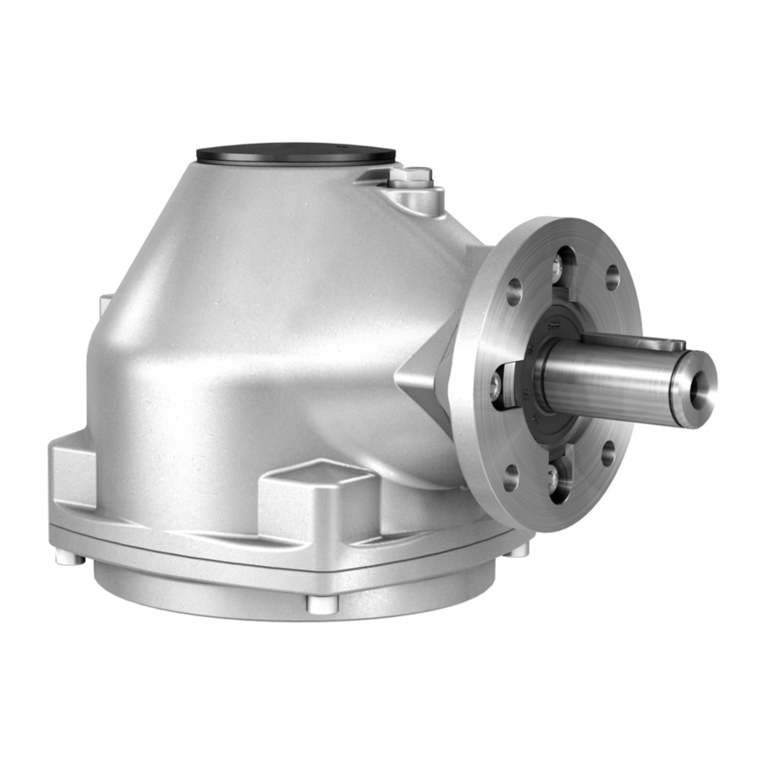
AUMA
AUMA GK 10.2 User manual
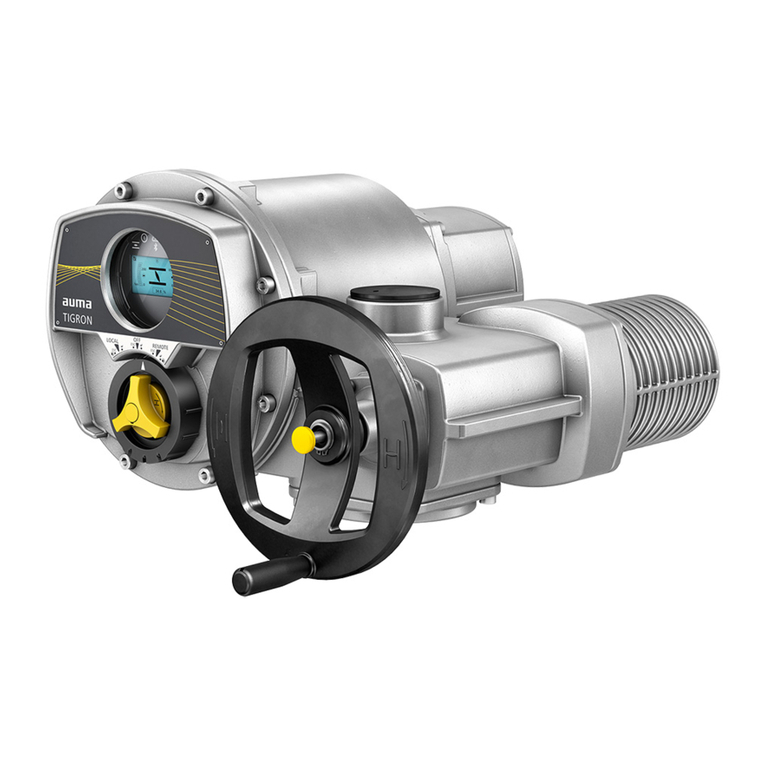
AUMA
AUMA TIGRON TR-M30X Manual
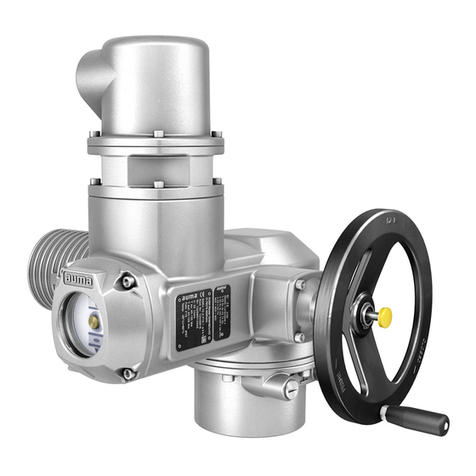
AUMA
AUMA SQEx 05.2 User manual
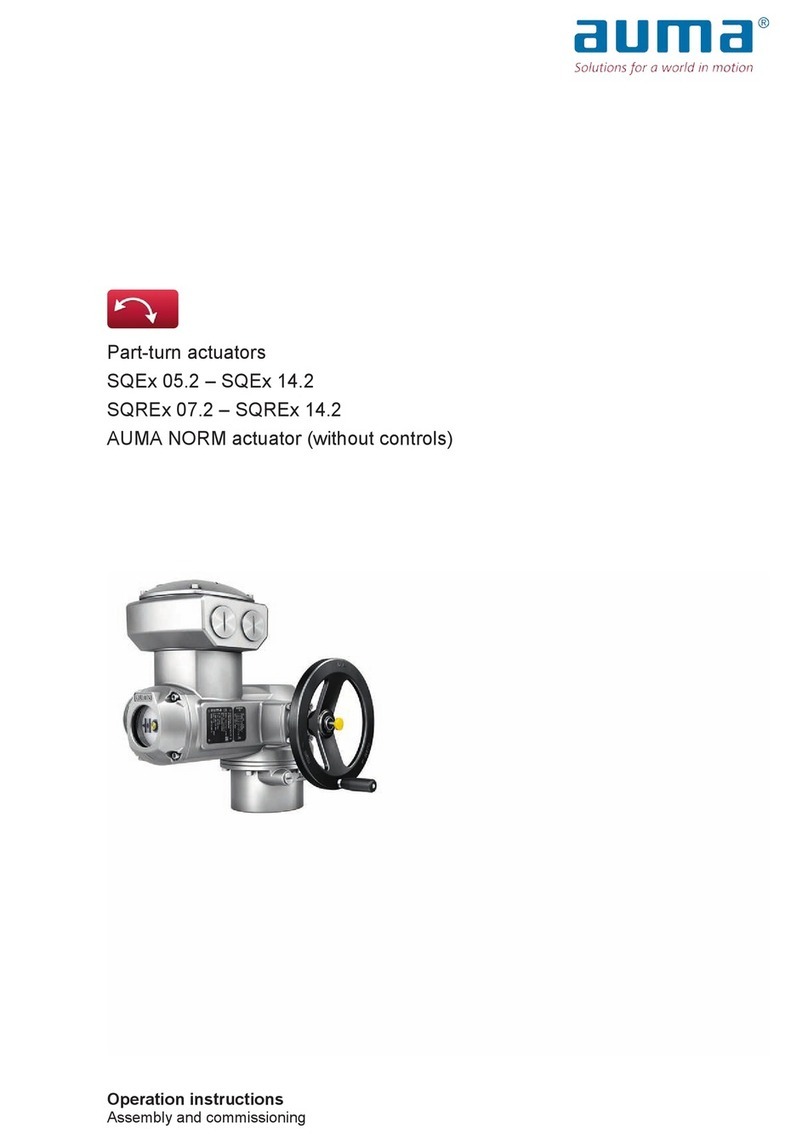
AUMA
AUMA SQEx 05.2 User manual
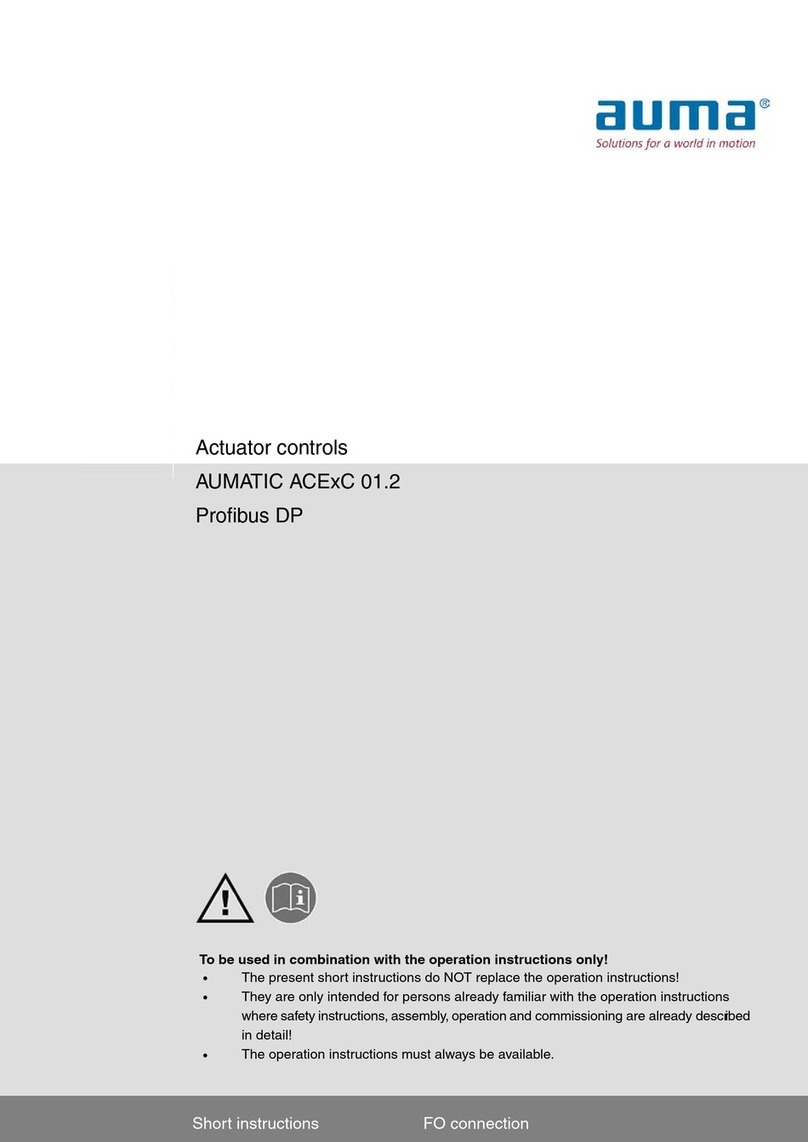
AUMA
AUMA AUMATIC ACExC User manual
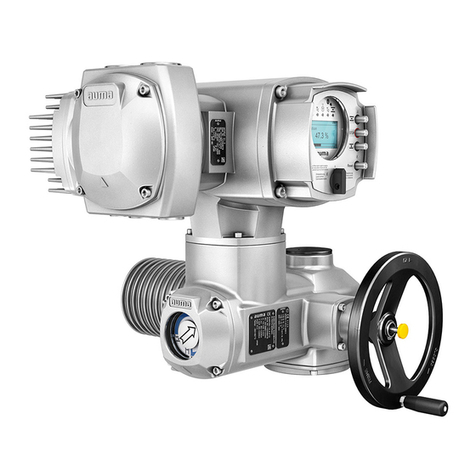
AUMA
AUMA SA Series User manual
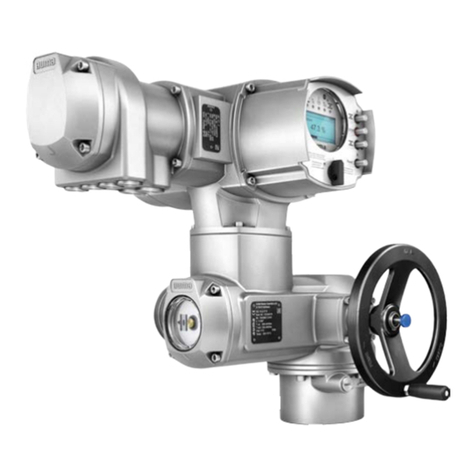
AUMA
AUMA SQ 05.2 User manual
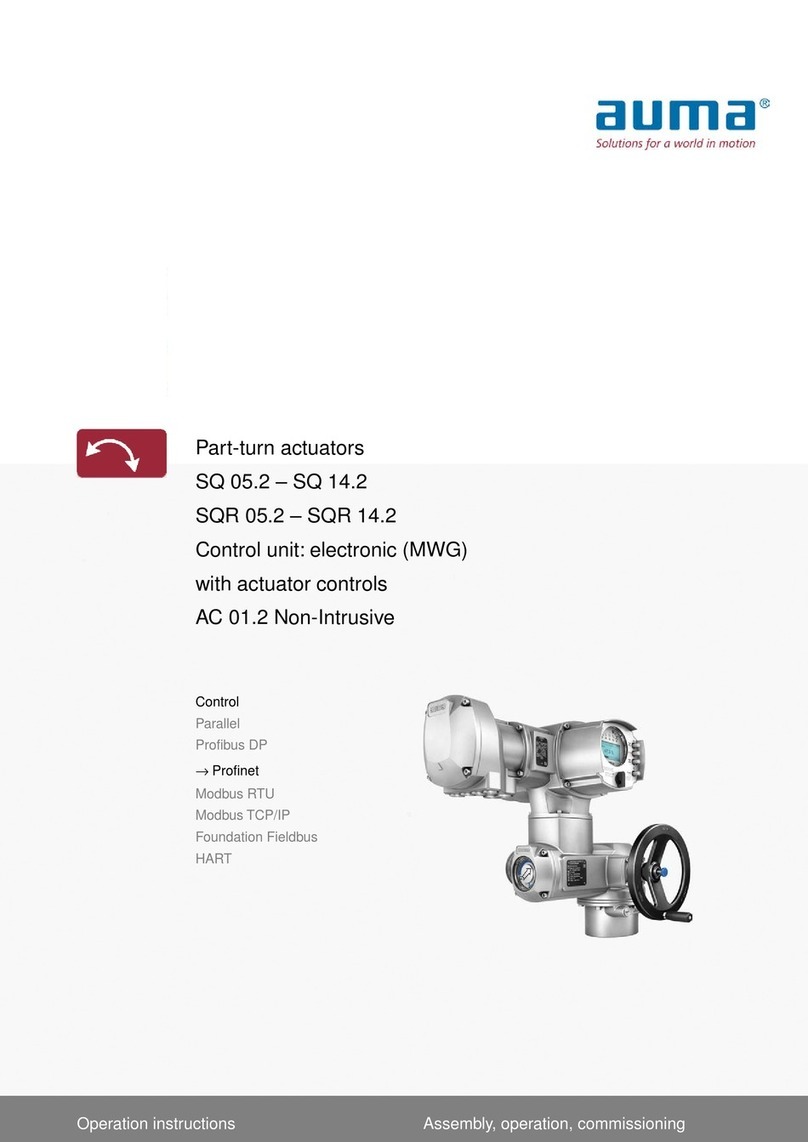
AUMA
AUMA SQ Series User manual

AUMA
AUMA SQEx 05.2 User manual
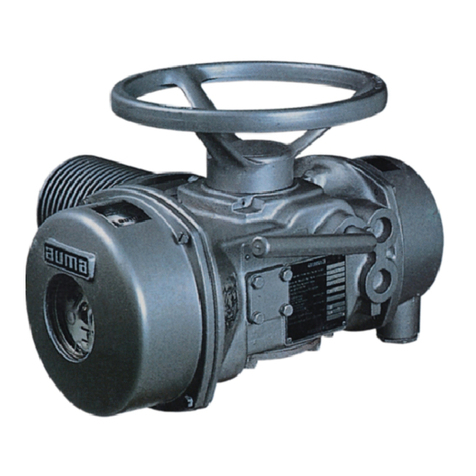
AUMA
AUMA SA3-SA100 User manual
